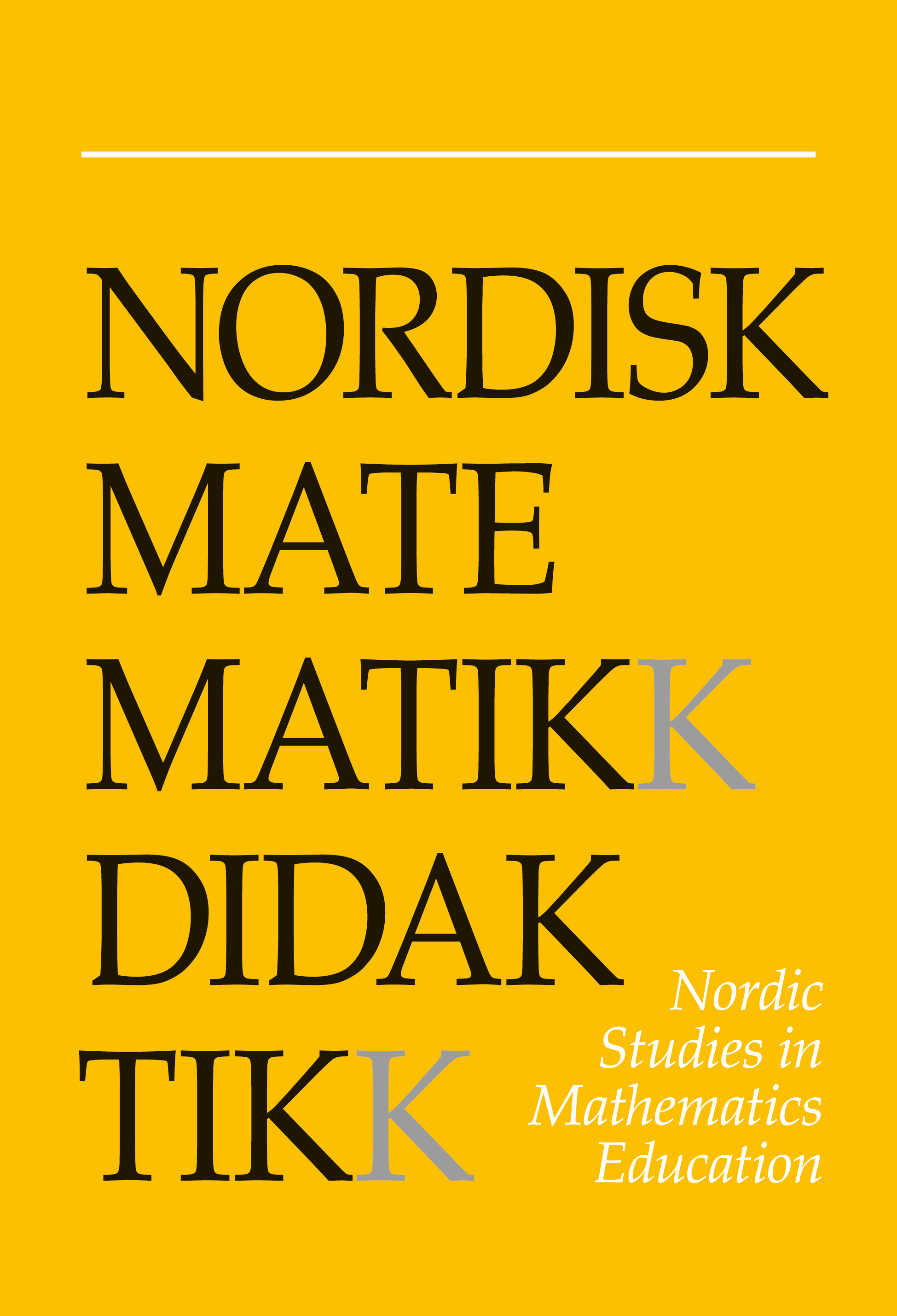Finnish students’ flexibility and its relation to speed and accuracy in equation solving
DOI:
https://doi.org/10.7146/nomad.v24i3-4.149023Abstract
A total of 266 Finnish students participated in a flexible equation solving test. By flexibility we understand the knowledge of multiple strategies and ability to choose the most mathematically appropriate strategy for a given task. Here we focus on the first aspect, namely knowledge of appropriate alternative, so-called innovative strategies. The test measured students’ capacity and inclination for producing innovative strategies. We consider the relationship between these measures and students’ speed and accuracy in solving equations. We find that students with high capacity for innovation have high speed and accuracy. On the other hand, some low capacity students had high speed or accuracy whereas others had low. Inclination for innovation is not related to speed or accuracy.
References
Andrews, P. (2013). Finnish mathematics teaching from a reform perspective: a video-based case-study analysis. Comparative Education Review, 57 (2), 189-211. https://doi.org/10.1086/669124
Attorps, I. (2006). Mathematics teachers' conceptions about equations (Doctoral dissertation). Helsinki: University of Helsinki.
Booth, J. L., Barbieri, C., Eyer, F. & Paré-Blagoev, E. J. (2014). Persistent and pernicious errors in algebraic problem solving. Journal of Problem Solving, 7, 10-23. https://doi.org/10.7771/1932-6246.1161
Buchbinder, O., Chazan, D. & Fleming, E. (2015). Insights into the school mathematics tradition from solving linear equations. For the Learning of Mathematics, 35, 2-8. https://www.jstor.org/stable/44382749
Freund, R. J., Wilson, W. J. & Sa, P. (2006). Regression analysis. Burlington: Academic Press.
Hästö, P., Palkki, R., Tuomela, D. & Star, J. (2019). Relationship between mathematical flexibility and success in national examinations. European Journal of Science and Mathematics Education, 7, 1-13. https://doi.org/10.30935/scimath/9530
Hatano, G. (2003). Foreword. In A. J. Baroody & A. Dowker (Eds.), The development of arithmetic concepts and skills (pp. 11-14). Mahwah: Erlbaum.
Heinze, A., Star, J. R. & Verschaffel, L. (2009). Flexible and adaptive use of strategies and representations in mathematics education. ZDM, 41, 535-540. doi: 10.1007/s11858-009-0214-4 https://doi.org/10.1007/s11858-009-0214-4
Hihnala, K. (2005). Laskutehtävien suorittamisesta käsitteiden ymmärtämiseen. Peruskoululaisen matemaattisen ajattelun kehittyminen aritmetiikasta algebraan siirryttäessä [Transition from the performing of arithmetic tasks to the understanding of concepts. The development of pupils' mathematical thinking when shifting from arithmetic to algebra in comprehensive school] (Doctoral dissertation). University of Jyväskylä.
Joglar Prieto, N., Abánades Astudillo, M. Á. & Star, J. (2018). Flexibilidad matemática y resolución de ecuaciones lineales [Mathematical flexibility and linear equation solving]. Uno: Revista de Didáctica de las Matemáticas, 80, 51-57.
Kupari, P., Vettenranta, J. & Nissinen, K. (2012). [Looking for student centered pedagogy: eight grade students' mathematics and science proficiency: international TIMSS-study in Finland]. Jyväskylä: Koulutuksen tutkimuslaitos.
Kupari, P., Välijärvi, J., Andersson, L., Arffman, I., Nissinen, K. et al. (2013). PISA12 ensituloksia [PISA12 first results]. Jyväskylä: Opetus- ja kulttuuriministeriö.
Lemaire, P. & Siegler, R. S. (1995). Four aspects of strategic change: contributions to children's learning of multiplication. Journal for Experimental Psychology: General, 124, 83-97. https://doi.org/10.1037/0096-3445.124.1.83
Liu, R.D., Wang, J., Star, J. R., Zhen, R., Jiang, R. H. & Fu, X. C. (2018). Turning potential flexibility into flexible performance: moderating effect of self- efficacy and use of flexible cognition. Frontiers in psychology, 9, 646. https://doi.org/10.3389/fpsyg.2018.00646
McMullen, J., Brezovszky, B., Hannula-Sormunen, M.M., Veermans, K., Rodríguez-Aflecht, G. et al. (2017). Adaptive number knowledge and its relation to arithmetic and pre-algebra knowledge. Learning and Instruction, 49, 178-187. https://doi.org/10.1016/j.learninstruc.2017.02.001
NCTM (2000). Principles and standards for school mathematics. Reston: NCTM. Opetushallitus (2014). Perusopetuksen opetussuunnitelman perusteet 2014 [National core curriculum for basic education 2014] (Opetushallitus, määräykset ja ohjeet 2014: 96). Tampere: Juvenes Print - Suomen yliopistopaino Oy.
Palkki, R. (2018). Matematiikan opettajien ja opettajaopiskelijoiden käsityksiä vertailumenetelmästä. LUMAT: International Journal on Math, Science and Technology Education, 6 (1), 105-128. https://doi.org/10.31129/LUMAT.6.1.327
Rittle-Johnson, B. & Star, J. R. (2007). Does comparing solution methods facilitate conceptual and procedural knowledge? An experimental study on learning to solve equations. Journal of Educational Psychology, 99 (3), 561-574. https://doi.org/10.1037/0022-0663.99.3.561
Schneider, M., Rittle-Johnson, B. & Star, J. R. (2011). Relations among conceptual knowledge, procedural knowledge, and procedural flexibility in two samples differing in prior knowledge. Developmental Psychology, 47 (6), 1525-1538. https://doi.org/10.1037/a0024997
Schoenfeld, A. H. (1992). Learning to think mathematically: sense-making in mathematics. In D. Grouws (Ed.), Handbook for research on mathematics teaching and learning (pp. 334-370). New York: MacMillan.
Star, J. R. (2005). Reconceptualizing procedural knowledge. Journal for Research in Mathematics Education, 36, 404-411. https://doi.org/10.2307/30034943
Star, J. R., Pollack, C., Durkin, K., Rittle-Johnson, B., Lynch, K. et al. (2015). Learning from comparison in algebra. Contemporary Educational Psychology, 40, 41-54. https://doi.org/10.1016/j.cedpsych.2014.05.005
Star, J. R. & Rittle-Johnson, B. (2008). Flexibility in problem solving: the case of equation solving. Learning and Instruction, 18 (6), 565-579. https://doi.org/10.1016/j.learninstruc.2007.09.018
Steuer, G. & Dresel, M. (2015). A constructive error climate as an element of effective learning environments. Psychological Test and Assessment Modeling, 57 (2), 262-275.
Torbeyns, J., Verschaffel, L. & Ghesquière, P. (2006). Development of children's strategy competencies in the number domain from 20 up to 100. Cognition and Instruction, 24, 439-465. https://doi.org/10.1207/s1532690xci2404_2
Törner, G. (1998). Mathematical beliefs and their impact on teaching and learning of mathematics. In E. Pehkonen & G. Törner (Eds.), The state-of-art in mathematics-related belief research: results of the MAVI activities (pp. 195, 73-94). Helsinki: University of Helsinki.
Verschaffel, L., Greer, B. & De Corte, E. (2007). Whole number concepts and operations. In F. Lester (Ed.), Second handbook of research on mathematics teaching and learning (pp. 557-628). Charlotte: Information Age Publishing.
Xu, L., Liu, R., Star, J.R., Wang, J., Liu, Y., Zhen, R. (2017). Measures of potential flexibility and practical flexibility in equation solving. Frontiers in Psychology, 8, 1368. https://doi.org/10.3389/fpsyg.2017.01368
Downloads
Published
How to Cite
Issue
Section
License

This work is licensed under a Creative Commons Attribution-NonCommercial-ShareAlike 4.0 International License.



